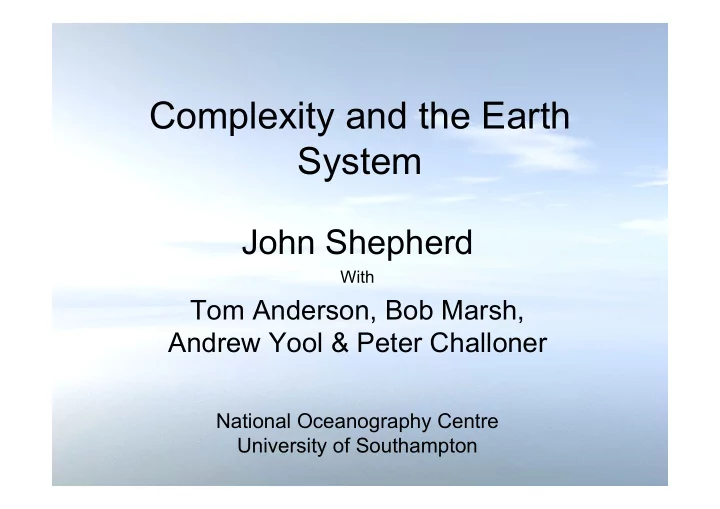

Complexity and the Earth System John Shepherd With Tom Anderson, Bob Marsh, Andrew Yool & Peter Challoner National Oceanography Centre University of Southampton
Earth from Space: the Blue Planet
Complexity in the What is oceanography? Earth System: Scientific study of the seas and oceans Oceans cover ~70% of the earth to average depth of 3.8 km structural & scientific Life originated in oceans, home to billions of creatures Oceans reservoir of natural materials and energy The Earth System comprises Ocean transport heat around surface of planet, Major influence on global climate • the solid Earth and the land surface Oceans essential for continuation of life on planet as we know • the hydrosphere (oceans, rivers & lakes) it • the atmosphere An INTERDISCIPLINARY science with major sub-disciplines • the cryosphere (sea-ice, glaciers and the ice caps) • the biosphere – both terrestrial and marine. • Interdisciplinary (we need many “ologies”) • Physics, Chemistry, Biology, Geology, Meteorology, Oceanography, Glaciology, Ecology…
The Earth System (according to GENIE) Slide courtesy of A. Slide courtesy of A. Ridgwell Ridgwell (Genie) (Genie)
Complexity in the What is oceanography? Scientific study of the seas and oceans Earth System Oceans cover ~70% of the earth to average depth of 3.8 km Life originated in oceans, home to billions of creatures Many variables (in 4 dimensions) Oceans reservoir of natural materials and energy Ocean transport heat around surface of planet, e.g. Temperature, Salinity, Velocity Major influence on global climate Phosphate, Nitrate, Silicate, Carbon (various) Oceans essential for continuation of life on planet as we know it Spatially heterogeneous An INTERDISCIPLINARY science with major sub-disciplines (so we need to resolve this to some extent) Time dependent (from hours to aeons) Highly non-linear; especially in physics => turbulence & eddies and in biology (too many species !!)…
Cascades: (1) of predation… Jonathan Swift (ca 1700); on predation • So, naturalists observe, a flea • has smaller fleas that on him prey; • And these have smaller still to bite ’em; • And so proceed, ad infinitum .
Cascades: (2) of turbulence L.F.Richardson (ca 1930) on turbulence … • “Big eddies have little eddies, • and little eddies have smaller eddies, • that feed on their vorticity, • and so on to viscosity.” (fractals and self-similarity are quite old ideas)
Mesoscale Eddies in Ocean & Atmosphere Satellite image of ocean colour (& visible - clouds): NE Pacific • Ocean eddies are smaller than atmospheric eddies, by an order of magnitude - yet “eddy” fluxes also play a key role in ocean circulation - with impacts on Climate and Biogeochemical Cycles
Eddy-resolving models of the World Ocean e.g., OCCAM (superseded by the NEMO project) four 3-D datasets (salinity, temperature, current): 4 x 1/12° x 1/12° x 66 levels ~60% ocean (full-depth equivalent - 71% ocean, average depth 4000 m) so 4 x 0.6 x 4320 x 1735 x 66 = 1,187,239,680 individual data values every 5 days for 1985-2006 = 1606 datasets, so ~1.9 x 10 12 data in total!
Future Developments? Free up the 3-D mesh to evolve in space and time High resolution only when & where you need it … Preliminary results of Imperial College Ocean Model (ICOM) Horizontal mesh in idealized basin 3-D visualization of convective event
Long-timescale climate processes Observations and theory suggest a global “Conveyor Belt”, maintaining stable climate over the last ~10,000 years Age of Based on offline upwelling deep water trajectory analysis, (years) it is clear that the model Conveyor timescales exceed 1000 years - So we need computationally cheaper models …
GENIE: a new Earth System Model of Intermediate Complexity: Bob Marsh et al (2001- now) ~2000 ~2001 ~2002 ~2005
Predicting the approach to GENIE-2 AMOC hysteresis loop (~3 weeks simulation) an AMOC bifurcation point (collapse) with an EMIC The ‘ACF propagator’ is a measure of slowing decay rate of perturbations in the data and hence the flatness of the potential well. A critical value of ‘1’ corresponds to infinitely slow decay and bifurcation—a flat potential Lenton, et al. (2009). Using GENIE to study a tipping point in the climate system. Phil. Trans. R. Soc. A, 367, 871-884. Doi:10.1098/rsta.2008.0171
Bob May Second Edition 1961(!)
North Atlantic food web (for fish only) from Link (2000) NB: Box 2 = all phytoplankton !!! (and Box 81 = humans)
How many species (or functional groups) is enough ?
NPZD model Andrew Yool & colleagues (NOC) (with ammonium and chlorophyll) “Biology” for Climate Models Zooplankton Chlorophyll Phytoplankton Nitrate Detrital N Ammonium
NPZD model plus carbon cycle Alkalinity Zooplankton Dissolved Inorganic Chlorophyll Carbon Phytoplankton Nitrate Detrital C Detrital N Ammonium
Dynamic “Green Ocean” model (Corinne le Quere & colleagues, UEA) 3 nutrients 6 phytop. 2 zoop. 5 detritus
PLANKTOM 5.0: implemented in two GCMs (Tom Anderson & colleagues, NOC) PO 4 light Fe SiO 3 DIC nanophytos calcifiers diatoms Microzoo- Mesozoo- plankton plankton DOM Si particulate large POM small POM CaCO 3
Phytoplankton functional types in two GCMs Yellow: diatoms, green: mixed phyto, brown: coccolithophores Bablu Sinha and Tom Anderson
Complex Models are too slow • Especially for Monte Carlo work • To get pdf’s & assess uncertainty (etc) • We need too many realisations… • But we can (sometimes) use Emulators • Peter Challoner & colleagues
Projections of AMOC strength for various IPCC scenarios
Probability of AMOC strength for various IPCC scenarios
Time trajectories of pdf’s of AMOC strength to 2100
Flux of CO 2 into the Ocean The seasonal cycle simulated by OCCAM (with thanks to Andrew Yool)
“Man has lost the capacity to foresee and to forestall. He will end by destroying the Earth” Albert Schweitzer, quoted by Rachel Carson, in her dedication of “Silent Spring”, (1962)
Recommend
More recommend